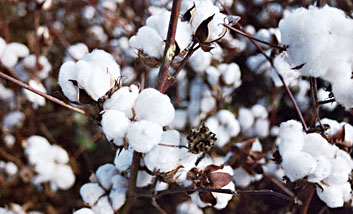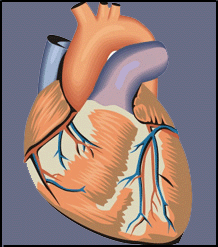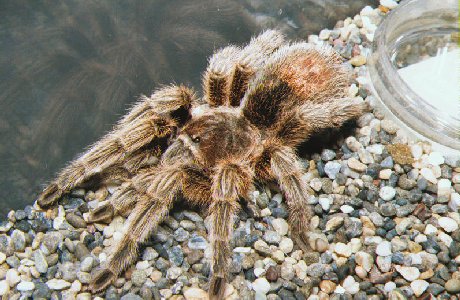Spider Venom
Applications of Spider Venom
Interest
in potential agricultural and medical uses of spider venom is largely due to its
selectivity in species and site of action.
Current research centres around exploring the development of pesticides
and drugs for treating cardiac patients.
Pesticides

 Components
in the neurotoxic venom of an Australian funnel-web spider have been found to be
specific for insects such as cockroaches, crickets, fruit-flies and the Helicoverpa
armigera moth which destroys cotton crops.
Targeting specific species prevents the accidental killing of other
insects.
This selectivity also means that the pesticide is harmless to other
organisms so there would be no danger if it entered the food chain.
The compounds in venom are environmentally friendly and the development
of resistance to a spider venom pesticide would be slow.
Traditional chemical pesticides do not tend to be species specific, are
toxic to humans in large amounts and insects develop resistance towards them
relatively fast so it is easy to see why pesticides based on spider venom are
attractive.
Components
in the neurotoxic venom of an Australian funnel-web spider have been found to be
specific for insects such as cockroaches, crickets, fruit-flies and the Helicoverpa
armigera moth which destroys cotton crops.
Targeting specific species prevents the accidental killing of other
insects.
This selectivity also means that the pesticide is harmless to other
organisms so there would be no danger if it entered the food chain.
The compounds in venom are environmentally friendly and the development
of resistance to a spider venom pesticide would be slow.
Traditional chemical pesticides do not tend to be species specific, are
toxic to humans in large amounts and insects develop resistance towards them
relatively fast so it is easy to see why pesticides based on spider venom are
attractive.
Prevention
of Atrial Fibrillation

 The
venom of the Chile Rose tarantula (Grammostola
spatulata) from South America contains an active protein, GsMtx-4, which
blocks ion channels that are stretch activated.
These channels are therefore sensitive to muscle contraction and blood
pressure and play an important role in co-ordinating a heartbeat.
A heart attack causes these ion channels to open and release chemicals
which interfere with the heart rhythm leading to atrial fibrillation.
Fibrillation is when the upper heart chambers (the atria) contract
rapidly and prevent sufficient blood from entering the lower chambers (the
venticles).
It is fibrillation which often causes the death of a heart attack victim,
not the attack itself so GsMtx-4 could be utilised in a potentially life-saving
drug which prevents fibrillation.
GsMtx-4 is ineffective on the normal unstretched heart so side effects
should be small or even non-existent.
The venom from the Chile Rose spider is also harmless to humans which
constitutes an extra safety precaution.
The
venom of the Chile Rose tarantula (Grammostola
spatulata) from South America contains an active protein, GsMtx-4, which
blocks ion channels that are stretch activated.
These channels are therefore sensitive to muscle contraction and blood
pressure and play an important role in co-ordinating a heartbeat.
A heart attack causes these ion channels to open and release chemicals
which interfere with the heart rhythm leading to atrial fibrillation.
Fibrillation is when the upper heart chambers (the atria) contract
rapidly and prevent sufficient blood from entering the lower chambers (the
venticles).
It is fibrillation which often causes the death of a heart attack victim,
not the attack itself so GsMtx-4 could be utilised in a potentially life-saving
drug which prevents fibrillation.
GsMtx-4 is ineffective on the normal unstretched heart so side effects
should be small or even non-existent.
The venom from the Chile Rose spider is also harmless to humans which
constitutes an extra safety precaution.
Prevention
of Brain Damage
 Oxygen
deprivation caused by events such as stroke or excessive smoke inhalation can
result in nerve cell damage in the brain.
Glutamate is a neurotransmitter in the human brain and large amounts of
it are released by these damaged neurons causing the death of neighbouring nerve
cells.
The Holena curta funnel-web spider produces a venom containing the
active ingredient HF-7 which blocks receptors on the nerve cell membranes and
prevents glutamate production.
A drug developed using this compound could therefore limit brain damage
for stroke victims.
Oxygen
deprivation caused by events such as stroke or excessive smoke inhalation can
result in nerve cell damage in the brain.
Glutamate is a neurotransmitter in the human brain and large amounts of
it are released by these damaged neurons causing the death of neighbouring nerve
cells.
The Holena curta funnel-web spider produces a venom containing the
active ingredient HF-7 which blocks receptors on the nerve cell membranes and
prevents glutamate production.
A drug developed using this compound could therefore limit brain damage
for stroke victims.

 Components
in the neurotoxic venom of an Australian funnel-web spider have been found to be
specific for insects such as cockroaches, crickets, fruit-flies and the Helicoverpa
armigera moth which destroys cotton crops.
Targeting specific species prevents the accidental killing of other
insects.
This selectivity also means that the pesticide is harmless to other
organisms so there would be no danger if it entered the food chain.
The compounds in venom are environmentally friendly and the development
of resistance to a spider venom pesticide would be slow.
Traditional chemical pesticides do not tend to be species specific, are
toxic to humans in large amounts and insects develop resistance towards them
relatively fast so it is easy to see why pesticides based on spider venom are
attractive.
Components
in the neurotoxic venom of an Australian funnel-web spider have been found to be
specific for insects such as cockroaches, crickets, fruit-flies and the Helicoverpa
armigera moth which destroys cotton crops.
Targeting specific species prevents the accidental killing of other
insects.
This selectivity also means that the pesticide is harmless to other
organisms so there would be no danger if it entered the food chain.
The compounds in venom are environmentally friendly and the development
of resistance to a spider venom pesticide would be slow.
Traditional chemical pesticides do not tend to be species specific, are
toxic to humans in large amounts and insects develop resistance towards them
relatively fast so it is easy to see why pesticides based on spider venom are
attractive.

